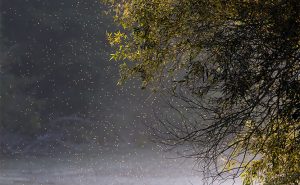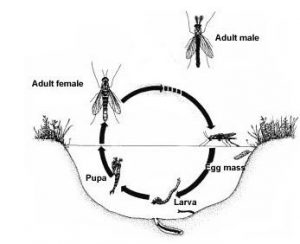By Art Malm, P.E., FOTFR Director
It’s that first warm, wonderful day of spring. The breeze is light; you feel the sun’s radiant energy through your light jacket. A perfect day to be paddling, or biking, or hiking, or just hanging out along the river. 
But ugh! Nasty swarms of bugs seem to be everywhere along the river’s edge getting into your hair, your ears, your teeth. They don’t seem interested in you or your food, but they certainly can ruin an otherwise picture perfect picnic.
Neighbors You Don’t Want
Meet the midges. Not our furry and feathery Fox Valley neighbors Jack MacRae writes about that make you want to go out and see for yourself the wondrous wildlife at our doorstep. Nope. These swarms of midges might just make you want to cower away from the riverfront and go inside.
There may be 10,000 species of midges. Also known as lake flies, bay flies or blind mosquitoes, midges can be found almost everywhere around the world. Unlike sand flies or mosquitoes most don’t bite. They’re just a nuisance.
To understand why midges are found most often along the river especially near the dams (and not just during the first warm days of spring) we need to talk about habitat and the midge life cycle.
Dwelling on the Bottom
Most midges live as larvae in the sediments at the bottom of lakes and ponds. With lots of food and very little competition, these oxygen deprived organic rich sediments provide the ideal midge habitat. In their home sediments where oxygen is scarce the only predator’s midges face are pollution tolerant species like carp and bullheads.
In fact, midges are so tolerant of pollution they often thrive in sewage treatment plants!
Midge flies spend almost their entire life underwater. After typically one to three years the aquatic midge larvae transition to the pupa stage  when they rise to the surface, sprout wings and fly.
when they rise to the surface, sprout wings and fly.
That’s when we see these dam flies in mating swarms. After a couple of intense days enjoying their life’s only mating frenzy the females drop their eggs and die. Midge fly life out of the water is so short that most, without even mouths to eat (or bite), don’t feed at all!
Low oxygen levels, organic rich sediments. If you’re thinking that sounds a lot like the impoundments behind Our Fox’s old obsolete dams you’re right. The April 2003 “Fox River Fish Passage Feasibility Study” for the Illinois Department of Natural Resources reported “Tolerant chironomid (midge) larvae and aquatic worms (Oligochaeta) combined to make up over 95% of organisms sampled from offshore areas of (dam) impoundments.”
On the other hand, “Free-flowing reaches supported higher quality macroinvertebrate communities” that don’t simply live to swarm, then die. In free flowing areas of Our Fox, always rich in oxygen and largely free of organic sediments, we find a much greater variety of macroinvertebrate critters. It is these clean water bugs that feed on algae, and help clean our river, while providing food for the minnows and game fish that have returned to many reaches of Our Fox.
So next time you ride or paddle or walk along the Fox on those warm, wonderful days of spring, and run into a swarm of mating midges feel free to imagine the future where a far healthier river, without dams, no longer supports the midge life cycle. Removing Our Fox’s dams won’t completely eliminate those pesky flies but dam removal will eliminate the impoundment habitat where they presently thrive.

